
Abracadabrella is a genus of spiders in the family Salticidae whose spp. appear to mimics flies. The type species for the genus was described by Ludwig Koch (1879) as Marptusa elegans, transferred to Ocrisiona by Eugène Simon (1901) then placed into Abracadabrella by Marek Żabka (1991).

Afraflacilla is a genus of the spider family Salticidae. Most species are distributed in Eastern to Northern Africa and Australia, with one species found in Europe. This genus was for a time included in the genus Pseudicius, and the boundaries between both genera are disputed. In 2016 Jerzy Prószyński erected the genus Psenuc for some borderline species. The name Afraflacilla is combined from Africa, where most earlier described species were found, and FlacillaSimon, 1901, an obsolete salticid genus now called FlacillulaStrand, 1932. This genus name is in turn derived from Aelia Flaccilla, wife of Roman Emperor Theodosius I. Afraflacilla, Pseudicius, Festucula and Marchena are close relatives and form a monophyletic group.
Grayenulla is a genus of Australian jumping spiders that was first described by Marek Michał Żabka in 1992.
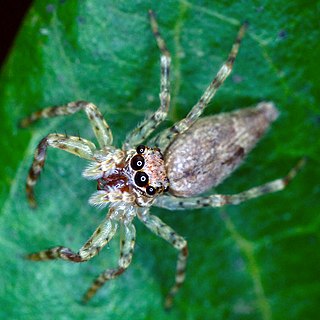
Helpis is a genus of the spider family Salticidae.
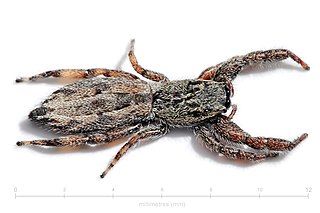
Holoplatys is a genus of the spider family Salticidae.
Jacksonoides is a spider genus of the jumping spider family, Salticidae.
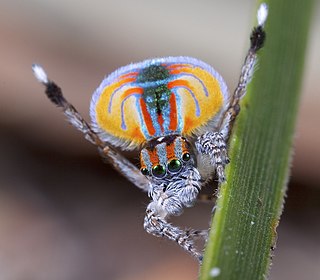
Maratus is a spider genus of the family Salticidae. These spiders are commonly referred to as peacock spiders due to the males' colorful and usually iridescent patterns on the upper surface of the abdomen often enhanced with lateral flaps or bristles, which they display during courtship. Females lack these bright colors, being cryptic in appearance. In at least one species, Maratus vespertilio, the expansion of the flaps also occurs during ritualised contests between males. The male display and courtship dance are complex, involving visual and vibratory signals.

Margaromma is a spider genus of the jumping spider family, Salticidae. The eight described species occur mostly in Australia and New Zealand, with several other species on Pacific islands. One species is found in Cameroon.
Mopsolodes is a genus of South Pacific jumping spiders that was first described by Marek Michał Żabka in 1991. As of July 2019 it contains only two species, found only in Australia and Papua New Guinea: M. australensis and M. furculosus. The name is derived from the closely related genus Mopsus.
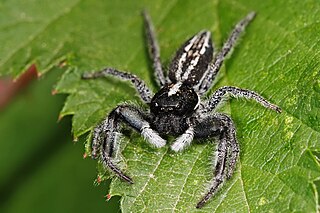
Ocrisiona is a genus of jumping spiders that was first described by Eugène Louis Simon in 1901. O. frenata from Hong Kong belongs to a different, unspecified genus, according to Marek Żabka (1990). Eugene Simon places the genus Ocrisiona close to Holoplatys.

Opisthoncus is a genus of South Pacific jumping spiders that was first described by Ludwig Carl Christian Koch in 1880. There are still many Australian species that have not yet been described.
Paraplatoides is a genus of South Pacific jumping spiders that was first described by Marek Michał Żabka in 1992.

Prostheclina is a genus of Australian jumping spiders that was first described by Eugen von Keyserling in 1882.

Sandalodes is a genus of jumping spiders that was first described by Eugen von Keyserling in 1883. S. scopifer, a black spider with white markings, is a common species in eucalypt forests on the Darling Downs.
Sondra is a genus of Australian jumping spiders that was first described by F. R. Wanless in 1988.

Synagelides is a genus of Asian jumping spiders that was first described by W. Bösenberg & Embrik Strand in 1906. This genus and Agorius are separated as a genus group, sometimes called subfamily Agoriinae, but more recently downranked to tribe Agoriini of the Salticoida clade in subfamily Salticinae.
Tauala is a genus of jumping spiders that was first described by F. R. Wanless in 1988. The name "Tauala" is an arbitrary combination of letters.
Abracadabrella birdsville is a species of jumping spider in the genus Abracadabrella. The scientific name of this species was first described in 1991 by Zabka. These spiders are usually easily found in Queensland.
Parahelpis is a genus of Australian jumping spiders that was first described by Joanna Gardzińska & Marek Michał Żabka in 2010. As of August 2019 it contains only two species, found only in New South Wales and Queensland: P. abnormis and P. smithae.
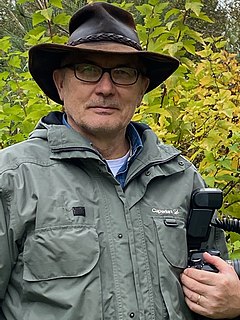
Marek Michał Żabka is a Polish arachnologist. His main research area is the spider family Salticidae, especially their systematics and biogeography. He has produced nearly 80 scientific publications, popular science articles and a book. The World Spider Catalog lists 25 genus names or synonyms and 237 species names or synonyms of which he is either the sole author or a co-author. Nine jumping spider species and one ant spider species have been given the specific name zabkai.











